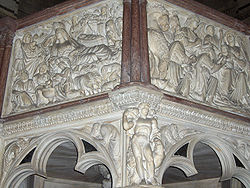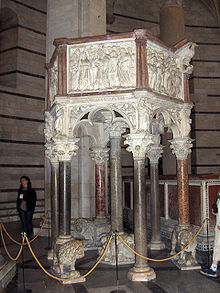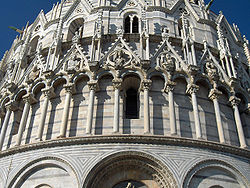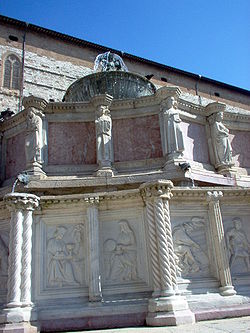
Nicola Pisano
Encyclopedia

Italy
Italy , officially the Italian Republic languages]] under the European Charter for Regional or Minority Languages. In each of these, Italy's official name is as follows:;;;;;;;;), is a unitary parliamentary republic in South-Central Europe. To the north it borders France, Switzerland, Austria and...
sculptor
Sculpture
Sculpture is three-dimensional artwork created by shaping or combining hard materials—typically stone such as marble—or metal, glass, or wood. Softer materials can also be used, such as clay, textiles, plastics, polymers and softer metals...
whose work is noted for its classical Roman
Ancient Rome
Ancient Rome was a thriving civilization that grew on the Italian Peninsula as early as the 8th century BC. Located along the Mediterranean Sea and centered on the city of Rome, it expanded to one of the largest empires in the ancient world....
sculptural style. Pisano is sometimes considered to be the founder of modern sculpture.
Early life
His birth date or origins are uncertain. He was born in ApuliaApulia
Apulia is a region in Southern Italy bordering the Adriatic Sea in the east, the Ionian Sea to the southeast, and the Strait of Òtranto and Gulf of Taranto in the south. Its most southern portion, known as Salento peninsula, forms a high heel on the "boot" of Italy. The region comprises , and...
, as the son of "Petrus de Apulia", as stated in the archives of the Cathedral of Siena. Nicola Pisano was probably trained in the local workshops of the emperor
Holy Roman Emperor
The Holy Roman Emperor is a term used by historians to denote a medieval ruler who, as German King, had also received the title of "Emperor of the Romans" from the Pope...
Frederick II
Frederick II, Holy Roman Emperor
Frederick II , was one of the most powerful Holy Roman Emperors of the Middle Ages and head of the House of Hohenstaufen. His political and cultural ambitions, based in Sicily and stretching through Italy to Germany, and even to Jerusalem, were enormous...
, and he attended his coronation. Here he was trained to give to the traditional representations more movement and emotions, intertwining Classical and Christian traditions. His only remaining works from this period are two griffon
Griffon
Griffon is a type of dog, a collection of breeds of originally hunting dogs. There are three recognized lines of the griffon type Fédération Cynologique Internationale FCI, the griffon vendéens, the wirehaired pointers, and the smousje...
heads with a soft chiaroscuro
Chiaroscuro
Chiaroscuro in art is "an Italian term which literally means 'light-dark'. In paintings the description refers to clear tonal contrasts which are often used to suggest the volume and modelling of the subjects depicted"....
effect.
Around 1245 he moved to Tuscany
Tuscany
Tuscany is a region in Italy. It has an area of about 23,000 square kilometres and a population of about 3.75 million inhabitants. The regional capital is Florence ....
to work at the Prato Castle. The lions on the portal of this castle are probably by his hand. "The head of a young girl" (now displayed in the Museo del Palazzo Venezia
Palazzo Venezia
The Palazzo di Venezia is a palazzo in central Rome, Italy, just north of the Capitoline Hill. The original structure of this great architectural complex consisted of a modest medieval house intended as the residence of the cardinals appointed to the Church of San Marco...
in Rome
Rome
Rome is the capital of Italy and the country's largest and most populated city and comune, with over 2.7 million residents in . The city is located in the central-western portion of the Italian Peninsula, on the Tiber River within the Lazio region of Italy.Rome's history spans two and a half...
), cut in hardstone of Elba
Elba
Elba is a Mediterranean island in Tuscany, Italy, from the coastal town of Piombino. The largest island of the Tuscan Archipelago, Elba is also part of the National Park of the Tuscan Archipelago and the third largest island in Italy after Sicily and Sardinia...
, is also ascribed to Nicola Pisano in the same period.
He moved to Lucca
Lucca
Lucca is a city and comune in Tuscany, central Italy, situated on the river Serchio in a fertile plainnear the Tyrrhenian Sea. It is the capital city of the Province of Lucca...
, working at façade of the Cathedral of Saint Martin
Duomo di San Martino
The Cathedral of St Martin is a church in Lucca, Italy. It was begun in 1063 by Bishop Anselm .-Description:Of the original structure, the great apse with its tall columnar arcades and the fine campanile remain...
, resulting in the relief Deposition from the Cross (on the north tympanum
Tympanum (architecture)
In architecture, a tympanum is the semi-circular or triangular decorative wall surface over an entrance, bounded by a lintel and arch. It often contains sculpture or other imagery or ornaments. Most architectural styles include this element....
) and the lintel reliefs Nativity and Adoration of the Magi.

Pulpit of the Pisa baptistery
He moved to PisaPisa
Pisa is a city in Tuscany, Central Italy, on the right bank of the mouth of the River Arno on the Tyrrhenian Sea. It is the capital city of the Province of Pisa...
between 1245 and 1250, where his son Giovanni Pisano
Giovanni Pisano
Giovanni Pisano was an Italian sculptor, painter and architect. Son of the famous sculptor Nicola Pisano, he received his training in the workshop of his father....
was born. Around 1255 he received a commission for the pulpit in the baptistery
Baptistry (Pisa)
The Baptistry of St. John is a religious building in Pisa, Italy. It started construction in 1152, in replacement of an older baptistry, and completed in 1363...
of Pisa. He finished this work in 1260 and signed with "Nicola Pisanus". He was aided by several assistants, among which were Arnolfo di Cambio
Arnolfo di Cambio
Arnolfo di Cambio was an Italian architect and sculptor.-Biography:Arnolfo was born in Colle Val d'Elsa, Tuscany....
and Lapo di Ricevuto.
In this pulpit, considered one of his masterworks, he succeeded in making a synthesis of the French Gothic style with the Classical style of ancient Rome, as he had seen on the sarcophagi
Sarcophagus
A sarcophagus is a funeral receptacle for a corpse, most commonly carved or cut from stone. The word "sarcophagus" comes from the Greek σαρξ sarx meaning "flesh", and φαγειν phagein meaning "to eat", hence sarkophagus means "flesh-eating"; from the phrase lithos sarkophagos...
of the Camposanto in Pisa, such as the scene Meleager
Meleager
In Greek mythology, Meleager was a hero venerated in his temenos at Calydon in Aetolia. He was already famed as the host of the Calydonian boar hunt in the epic tradition that was reworked by Homer....
hunting the Calydonian Boar on a sarcophagus brought as booty to Pisa by its navy. Vasari relates that Nicola Pisano constantly studied these Roman remains and the Roman sculptures from Augustan
Augustus
Augustus ;23 September 63 BC – 19 August AD 14) is considered the first emperor of the Roman Empire, which he ruled alone from 27 BC until his death in 14 AD.The dates of his rule are contemporary dates; Augustus lived under two calendars, the Roman Republican until 45 BC, and the Julian...
times seem to have marked a deep impression on him. In the panel Representation the Madonna reminds us of the regal bearing of goddesses in late Roman sculpture, while the expressive face of St. Anne shows the ravages of age.

Telamon
In Greek mythology, Telamon , son of the king Aeacus, of Aegina, and Endeis and brother of Peleus, accompanied Jason as one of his Argonauts, and was present at the hunt for the Calydonian Boar. In the Iliad he was the father of Greek heroes Ajax the Great and Teucer the Archer by different...
s and is surrounded by six columns of different height, three of which rest on a lion, while the other three rest on octagonal bases. The columns came from remains at Ostia
Ostia Antica
Ostia Antica is a large archeological site, close to the modern suburb of Ostia , that was the location of the harbour city of ancient Rome, which is approximately 30 km to the northeast. "Ostia" in Latin means "mouth". At the mouth of the River Tiber, Ostia was Rome's seaport, but, due to...
. The Corinthian
Corinthian order
The Corinthian order is one of the three principal classical orders of ancient Greek and Roman architecture. The other two are the Doric and Ionic. When classical architecture was revived during the Renaissance, two more orders were added to the canon, the Tuscan order and the Composite order...
capitals
Capital (architecture)
In architecture the capital forms the topmost member of a column . It mediates between the column and the load thrusting down upon it, broadening the area of the column's supporting surface...
support trefoil Gothic arches, richly decorated with Prophets and Evangelists in the spandrel
Spandrel
A spandrel, less often spandril or splaundrel, is the space between two arches or between an arch and a rectangular enclosure....
s. These arches are separated by sculptures of St. John the Baptist, St. Michael and the Virtues and, surprisingly, a nude Hercules
Hercules
Hercules is the Roman name for Greek demigod Heracles, son of Zeus , and the mortal Alcmene...
.
The hexagonal pulpit itself consists of five scenes in white Carrara marble from the Life of Christ : the Nativity, the Annunciation, the Annunciation to the Shepherds are juxtaposed in the first relief, the Adoration of the Magi, the Presentation, the Crucifixion and the Last Judgement. The backgrounds of these scenes were originally painted and enamelled, while the eyes of the figures were coloured. This contributed to a realistic depiction of these religious scenes. All these scenes, except the last two, reflect his knowledge of the style on the sarcophagi. The figures wear tunics
Tunic
A tunic is any of several types of clothing for the body, of various lengths reaching from the shoulders to somewhere between the hips and the ankles...
in a Roman fashion. The Virgin wears a pallium
Pallium
The pallium is an ecclesiastical vestment in the Roman Catholic Church, originally peculiar to the Pope, but for many centuries bestowed by him on metropolitans and primates as a symbol of the jurisdiction delegated to them by the Holy See. In that context it has always remained unambiguously...
over her head in the same manner as a Roman matron.
The scene The Last Judgement was probably based on a Byzantine
Byzantine
Byzantine usually refers to the Roman Empire during the Middle Ages.Byzantine may also refer to:* A citizen of the Byzantine Empire, or native Greek during the Middle Ages...
ivory and The Crucifixion was sculpted with the same elegance as contemporary French Gothic art.
He must have found his inspiration for this pulpit in the triumphal arches he had seen in Rome when travelling to Ostia. The form of this pulpit diverges completely from contemporary art. The sculptures are represented in the same manner as those of the Arch of Constantine
Arch of Constantine
The Arch of Constantine is a triumphal arch in Rome, situated between the Colosseum and the Palatine Hill. It was erected to commemorate Constantine I's victory over Maxentius at the Battle of Milvian Bridge on October 28, 312...
in Rome, with the figures standing atop columns. Furthermore, the same arch has an attic storey with sculpted scenes, as does the pulpit.

Diotisalvi
Diotisalvi, Deotisalvi or Deustesalvet was an architect from Pisa, Italy, active in the 12th century in Pisa. Little is known of him.- Biography :...
on the dome of the baptistery. He increased its height with a system of two domes : a small truncated cone on top of the hemispherical dome. The two rows of traceried
Tracery
In architecture, Tracery is the stonework elements that support the glass in a Gothic window. The term probably derives from the 'tracing floors' on which the complex patterns of late Gothic windows were laid out.-Plate tracery:...
gable
Gable
A gable is the generally triangular portion of a wall between the edges of a sloping roof. The shape of the gable and how it is detailed depends on the structural system being used and aesthetic concerns. Thus the type of roof enclosing the volume dictates the shape of the gable...
s were later decorated by his son Giovanni Pisano
Giovanni Pisano
Giovanni Pisano was an Italian sculptor, painter and architect. Son of the famous sculptor Nicola Pisano, he received his training in the workshop of his father....
between 1277 and 1284.
Shrine of Saint Dominic (Bologna)
During 1264 he was asked to work on the Shrine of Saint DominicArca di San Domenico
The Arca di San Domenico is a monument containing the remains of Saint Dominic. It is located in Dominic’s Chapel in the Basilica of San Domenico in Bologna, Italy.- History :...
in the Basilica of San Domenico
Basilica of San Domenico
The Basilica of San Domenico is one of the major churches in Bologna, Italy. The remains of Saint Dominic, founder of the Order of Preachers , are buried inside the exquisite shrine Arca di San Domenico, made by Nicola Pisano and his workshop, Arnolfo di Cambio and with later additions by Niccolò...
in Bologna
Bologna
Bologna is the capital city of Emilia-Romagna, in the Po Valley of Northern Italy. The city lies between the Po River and the Apennine Mountains, more specifically, between the Reno River and the Savena River. Bologna is a lively and cosmopolitan Italian college city, with spectacular history,...
. He was certainly responsible for the design, but his input was probably minimal. In 1265 he was already at work on the pulpit for the Siena Cathedral. The front side was done in his workshop, partially by Nicola Pisano himself but mostly by his assistant Lapo di Ricevuto. It would almost take 500 years to finish this shrine through the work of famous sculptors: Arnolfo di Cambio
Arnolfo di Cambio
Arnolfo di Cambio was an Italian architect and sculptor.-Biography:Arnolfo was born in Colle Val d'Elsa, Tuscany....
, fra Guglielmo Agnelli
Guglielmo Agnelli
Fra. Guglielmo Agnelli was an Italian sculptor and architect, born in Pisa.- History :Agnelli was a pupil of Nicola Pisano, who had brought the art of sculpture to great perfection, modeled on Greek and Roman ideas, matured by the study of actual truth, and preserving only traditions of the...
, Niccolò dell'Arca, the young Michelangelo
Michelangelo
Michelangelo di Lodovico Buonarroti Simoni , commonly known as Michelangelo, was an Italian Renaissance painter, sculptor, architect, poet, and engineer who exerted an unparalleled influence on the development of Western art...
, Girolamo Coltellini and Giovanni Batista Boudard. The expressive face of saint Dominic, so different from the more blander faces in the front panel "Saint Dominic resurrects Napoleone Orsini", is attributed to Arnolfo di Cambio.
Pulpit of the Siena Cathedral
In September 1265 he was given his next major assignment : a marble pulpit for the Siena Cathedral. This pulpit, made of CarraraCarrara
Carrara is a city and comune in the province of Massa-Carrara , notable for the white or blue-grey marble quarried there. It is on the Carrione River, some west-northwest of Florence....
marble, was sculpted between the end of 1265 and November 1268 with the extensive participation of his son Giovanni Pisano
Giovanni Pisano
Giovanni Pisano was an Italian sculptor, painter and architect. Son of the famous sculptor Nicola Pisano, he received his training in the workshop of his father....
and his assistants Arnolfo di Cambio
Arnolfo di Cambio
Arnolfo di Cambio was an Italian architect and sculptor.-Biography:Arnolfo was born in Colle Val d'Elsa, Tuscany....
, Lapo di Ricevuto and several other artists.
This is the earliest remaining work in the cathedral. Nicola Pisano was given this commission due to his fame by the Pisa pulpit. This pulpit, resembling the Pisa pulpit but larger, is even more ambitious and is considered his masterpiece. The whole message of the pulpit is concerned with the doctrine of Salvation
Salvation
Within religion salvation is the phenomenon of being saved from the undesirable condition of bondage or suffering experienced by the psyche or soul that has arisen as a result of unskillful or immoral actions generically referred to as sins. Salvation may also be called "deliverance" or...
and the Last Judgment
Last Judgment
The Last Judgment, Final Judgment, Day of Judgment, Judgment Day, or The Day of the Lord in Christian theology, is the final and eternal judgment by God of every nation. The concept is found in all the Canonical gospels, particularly the Gospel of Matthew. It will purportedly take place after the...
.
Pistoia and Perugia
In July 1273 Nicola Pisano was commissioned by the Operai di San Jacopo of PistoiaPistoia
Pistoia is a city and comune in the Tuscany region of Italy, the capital of a province of the same name, located about 30 km west and north of Florence and is crossed by the Ombrone Pistoiese, a tributary of the River Arno.-History:...
to make the altar of San Jacopo in the cathedral of San Zeno
Pistoia Cathedral
Pistoia Cathedral is the main religious building of Pistoia, Tuscany, central Italy, located in the Piazza del Duomo in the centre of the city. It is the seat of the Bishop of Pistoia and is dedicated to Saint Zeno of Verona....
. He worked on it together with his son Giovanni. The chapel of San Jacopo was demolished in 1786. The Holy Water stoup with its three female figures was probably sculpted at the same time. Giovanni Pisano would later make his first pulpit in the same cathedral.

Fontana Maggiore
The Fontana Maggiore is a monumental medieval fountain located between the cathedral and the Palazzo dei Priori in the city of Perugia in Italy. It was made between 1277 and 1278 by sculptors Nicola Pisano and Giovanni Pisano...
at Perugia
Perugia
Perugia is the capital city of the region of Umbria in central Italy, near the River Tiber, and the capital of the province of Perugia. The city is located about north of Rome. It covers a high hilltop and part of the valleys around the area....
(1277–1278). The fountain with three superposed basins was designed by Fra Bevignate and Boninsegna. The fountain certainly shows the delicate hand of Nicolò Pisano, but most sculpting was executed by his son Giovanni Pisano and his assistants. By its richness in details and by its iconography
Iconography
Iconography is the branch of art history which studies the identification, description, and the interpretation of the content of images. The word iconography literally means "image writing", and comes from the Greek "image" and "to write". A secondary meaning is the painting of icons in the...
, this last work shows a rapprochement to French Gothic art.
Conclusion
He wasn't just an imitator of the Classical antiquity. His figures are original creations that came into being through a thorough study and understanding of the antique prototypes. He is the most important precursor of Italian RenaissanceRenaissance
The Renaissance was a cultural movement that spanned roughly the 14th to the 17th century, beginning in Italy in the Late Middle Ages and later spreading to the rest of Europe. The term is also used more loosely to refer to the historical era, but since the changes of the Renaissance were not...
sculpture by reinstating antique representations. Therefore, surveys of the Italian Renaissance usually begin with the year 1260, the year that Nicola Pisano dated this pulpit in the Pisa baptistery.
However, as the pulpit of the Siena Cathedral shows, Nicola Pisano was still attached to the contemporary Gothic art. However this appreciation may arise because this pulpit was finished by his son Giovanni Pisano
Giovanni Pisano
Giovanni Pisano was an Italian sculptor, painter and architect. Son of the famous sculptor Nicola Pisano, he received his training in the workshop of his father....
who didn't appreciate this liking for the Antiquity in the same manner.
Both styles coexisted for several generations and International Gothic
International Gothic
International Gothic is a phase of Gothic art which developed in Burgundy, Bohemia, France and northern Italy in the late 14th century and early 15th century...
and its variations would even become more popular in the 15th century than the Classicism of the High Renaissance.
Nicola Pisano has pushed 13th century Tuscan sculpture in the direction of a Gothic art that already integrated the noble features of Roman art, while simultaneously staying attached to the Gothic art from Northern Europe.
The true inheritor of his classical style was Arnolfo di Cambio
Arnolfo di Cambio
Arnolfo di Cambio was an Italian architect and sculptor.-Biography:Arnolfo was born in Colle Val d'Elsa, Tuscany....
(c. 1250-1302), whose early death left the field clear for Giovanni Pisano, who, by then, was already pursuing his own mixture of French Gothic and the classical style.
Giorgio Vasari
Giorgio Vasari
Giorgio Vasari was an Italian painter, writer, historian, and architect, who is famous today for his biographies of Italian artists, considered the ideological foundation of art-historical writing.-Biography:...
included a biography of Nicola Pisano in his Lives
Lives of the Most Excellent Painters, Sculptors, and Architects
The Lives of the Most Excellent Italian Painters, Sculptors, and Architects, from Cimabue to Our Times, or Le Vite de' più eccellenti pittori, scultori, e architettori da Cimabue insino a' tempi nostri, as it was originally known in Italian, is a series of artist biographies written by 16th century...
.

